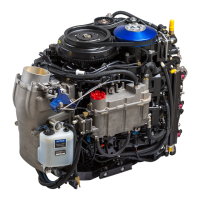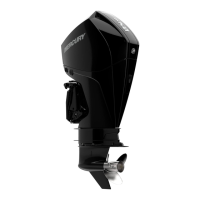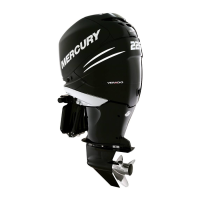Fuel System Specifications
Fuel System Specifications
Recommended fuel octane rating 87 (R+M)/2, 91 RON
Approximate fuel pressure at idle 290–340 kPa (42.1–43.9 psi)
Approximate fuel pressure engine not running 340–370 kPa (49.3–53.7 psi)
Fuel filtration
Inlet filter, engine mounted 10 microns
Inlet filter, remote boat mounted 10 microns
High‑pressure, at fuel rail inlet 46 microns
Fuel pump current draw 12 A ± 2 A (at 14.4 V)
Maximum fuel system inlet vacuum 10.16 kPa (3.0 in. Hg), (1.47 psi)
Fuel System Overview
Theory of Operation
The sequential multiport fuel injection system uses an electronic propulsion control module (PCM) and multiple input sensors to
maintain optimum injector volume (pulse width) and injection timing control.
Two fuel pumps are located inside a sealed, water‑cooled, fuel supply module (FSM). The FSM contains a fuel lift pump, a
high‑pressure fuel pump, a fuel pressure regulator, and a fuel cooler. The FSM is mounted in front of the exhaust tube in the
midsection of the engine. A reference hose on the intake manifold is connected to the fuel pressure regulator inside the FSM.
Fuel is recirculated inside the FSM to regulate fuel rail pressure.
The PCM uses data collected from the manifold absolute pressure (MAP) sensor to determine the ambient barometric (BARO)
pressure and monitor pressure changes inside the plenum. An intake air temperature (IAT) sensor, located on the starboard
intake runner, sends air temperature data to the PCM. Engine speed and valve position are monitored by a crankshaft position
sensor (CPS) and a camshaft position sensor. An O2 sensor is mounted in the exhaust manifold to help monitor fuel delivery
and maintain the ideal fuel‑to‑air ratio at the desired emissions target.
Electronic throttle control (ETC) is modulated by the PCM. The PCM converts digital position signals from the ERC (DTS
models) or throttle demand sensor (mechanical throttle and shift models) and positions the throttle plate accordingly. Two
throttle position sensors (TPS) are used to ensure the accuracy of the throttle plate position. ETC also acts as an idle air
control, increasing or decreasing the throttle plate opening as necessary to ensure optimum idle and performance
characteristics.
Fuel System
!
WARNING
Fuel is flammable and explosive. Ensure that the key switch is off and the lanyard is positioned so that the engine cannot
start. Do not smoke or allow sources of spark or open flame in the area while servicing. Keep the work area well ventilated
and avoid prolonged exposure to vapors. Always check for leaks before attempting to start the engine, and wipe up any
spilled fuel immediately.
IMPORTANT: Use an approved container to collect and store fuel. Wipe up spilled fuel immediately. Material used to contain
spilled fuel must be disposed of in an approved receptacle.
Before servicing any part of the fuel system:
1. Stop engine and disconnect the battery.
2. Perform fuel system service in a well‑ventilated area.
3. Inspect any completed service work for sign of fuel leakage.
Fuel Injector
The fuel injector is an electrically operated, spring‑loaded solenoid that delivers a metered amount of fuel into the intake
manifold runner just ahead of the intake valves. The fuel injector is electrically charged when the key switch is set to the RUN
position. The PCM completes the ground circuit of the injector, activating the injector's solenoid and allowing the flow of
high‑pressure fuel into the combustion chamber. The PCM then opens the ground circuit, allowing the spring to close the
injector and stop the fuel flow. There are two separate streams of fuel aimed at the intake valves, for better atomization of the
fuel. The fuel injector is not serviceable.
Fuel System
Page 7A-2 © 2018 Mercury Marine 90-8M0146617 eng JULY 2018

